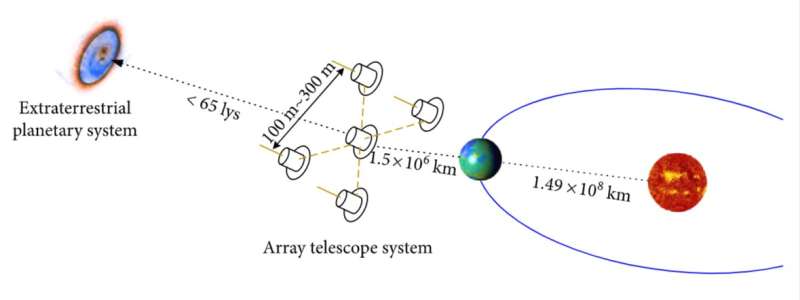Mission design of an aperture-synthetic interferometer system for space-based exoplanet exploration

The search for extraterrestrial life and exploration of "another Earth" is an eternal theme for humans and inspires generations of planetary scientists. It not only improves our understanding of the formation and evolution of planets during the formation of a star system but also helps scientists to investigate the possible conditions and criteria of the existence of life. In the past 30 years, scientists have discovered more than 4,000 exoplanets, but exploration still has a long way to go.
Due to the far distance, searching for exoplanets requires high sensitivity and high resolution. The space-based telescope can eliminate the interference of the Earth's atmosphere on observations and became a trend in exoplanet exploration. As a next-generation telescope configuration, the array telescope is expected to realize the cross-generation of the telescope system so that an Earth-like exoplanet near a Sun-like host star could be detected and characterized via direct imaging.
In a research paper recently published in Space: Science & Technology, Xiangyu Li from Beijing Institute of Technology focuses on a space-based exoplanet exploration mission and analyzes its scientific background, mission profile, trajectory design method, and orbital maintenance technique, which deploys several satellites to form an aperture-synthetic interferometer system in space to help discover exoplanets.
The author first proposed four observation demands of the array telescope, which are necessities to search for and characterize habitable exoplanets in our solar system's neighbors (within 65 light-years).
- High spatial resolution. The star-planet angular distance is better than 0.01 arcsec 65 light-years away from the Sun.
- High contrast. The brightness of planets and stars differs by at least 7 orders of magnitude in the midinfrared band.
- High sensitivity. The brightness of the planet in the signal dominant band is less than 3 photons/sec/m2.
- Wide spectral range. Indirect observation in the near-infrared band of 1 to 5 μm and direct observation in the near-infrared band of 1 to 13 μm.
Afterwards, the principles of the two-element nulling interferometer and the four-element nulling interferometer were introduced, respectively. Based on the characteristics of the observation demands and the principle of interferometry, the general requirements for the array telescope system were concluded for the trajectory design.
Then, the methods for the mission orbit selection and transfer trajectory design were proposed. The Sun-Earth L2 halo orbit is selected as the mission orbit due to two main reasons. On one hand, the ideal mission orbit should keep away from the electromagnetic interference of the Earth. On the other hand, a relatively clean dynamic environment is required to reduce the magnitude and the frequency of orbit maintenance. Based on the selected periodic orbit, the stable invariant manifolds of the periodic orbits were used to find the low-energy transfer opportunity. The transfer trajectory was designed through a three-step procedure. Firstly, based on the circular restricted three-body problem, the stable manifolds of the target mission orbit at different phase angles were generated, and the branch approaching the Earth was selected. Secondly, the Poincare map was selected according to the perigee state constraint. Thirdly, the corresponding manifold that satisfied the height constraint of the parking orbit was chosen as the initial guess of the transfer trajectory. For the maintenance of the formation configuration around the libration point, the constraint of maximum drift error bound existed and the control law based on the tangent targeting method was proposed to maximize the time spent within the error bound between maneuvers.
Finally, numerical simulations were implemented to validate the efficiency of the proposed method. Two main findings were worthy of mention. In the phase of orbital transfer, the multiple perigees of the manifold were found to reduce the total transfer time to one and a half years, and each transfer only needed a velocity increment less than 10 m/s to achieve the insertion of the halo orbit. In the phase of orbit maintenance, the spacecraft can satisfy the relative position stability constraints at a maintenance frequency of once every two days approximately, with the whole velocity increments of each spacecraft are less than 5×10−4 m/s when the error bound is 0.1 m.
More information: Feida Jia et al, Mission Design of an Aperture-Synthetic Interferometer System for Space-Based Exoplanet Exploration, Space: Science & Technology (2022). DOI: 10.34133/2022/9835234
Provided by Beijing Institute of Technology



















